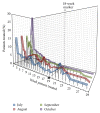One-Stop Clinic Utilization in Plastic Surgery: Our Local Experience and the Results of a UK-Wide National Survey
- PMID: 26236502
- PMCID: PMC4506812
- DOI: 10.1155/2015/747961
One-Stop Clinic Utilization in Plastic Surgery: Our Local Experience and the Results of a UK-Wide National Survey
Abstract
Introduction. "See and treat" one-stop clinics (OSCs) are an advocated NHS initiative to modernise care, reducing cancer treatment waiting times. Little studied in plastic surgery, the existing evidence suggests that though they improve care, they are rarely implemented. We present our experience setting up a plastic surgery OSC for minor skin surgery and survey their use across the UK. Methods. The OSC was evaluated by 18-week wait target compliance, measures of departmental capacity, and patient satisfaction. Data was obtained from 32 of the 47 UK plastic surgery departments to investigate the prevalence of OSCs for minor skin cancer surgery. Results. The OSC improved 18-week waiting times, from a noncompliant mean of 80% to a compliant 95% average. Department capacity increased 15%. 95% of patients were highly satisfied with and preferred the OSC to a conventional service. Only 25% of UK plastic surgery units run OSCs, offering varying reasons for not doing so, 42% having not considered their use. Conclusions. OSCs are underutilised within UK plastic surgery, where a significant proportion of units have not even considered their benefit. This is despite associated improvements in waiting times, department capacity, and levels of high patient satisfaction. We offer our considerations and local experience instituting an OSC service.
Figures






Similar articles
-
Improving satisfaction ratings of surgical patients from referral to follow-up in the faculty medical center clinic.J Surg Educ. 2011 Sep-Oct;68(5):360-4. doi: 10.1016/j.jsurg.2011.03.008. Epub 2011 May 26. J Surg Educ. 2011. PMID: 21821213
-
Variations in clinical audit collection: a survey of plastic surgery units across the British Isles.Ann R Coll Surg Engl. 2006 Mar;88(2):196-8. doi: 10.1308/003588406X83005. Ann R Coll Surg Engl. 2006. PMID: 16551418 Free PMC article.
-
Tumor suppressor gene, cell surface adhesion molecule, and multidrug resistance in Müllerian serous carcinomas: clinical divergence without immunophenotypic differences.Gynecol Oncol. 2000 Dec;79(3):430-7. doi: 10.1006/gyno.2000.6000. Gynecol Oncol. 2000. PMID: 11104615
-
Academic Status of Plastic Surgery in the United States and the Relevance of Independence.Handchir Mikrochir Plast Chir. 2016 Apr;48(2):65-8. doi: 10.1055/s-0042-104373. Epub 2016 Apr 20. Handchir Mikrochir Plast Chir. 2016. PMID: 27096203 Review.
-
The surgical waiting time initiative: A review of the Nigerian situation.Niger Med J. 2014 Nov;55(6):443-51. doi: 10.4103/0300-1652.144692. Niger Med J. 2014. PMID: 25538359 Free PMC article. Review.
Cited by
-
Improving waiting times in the orthopaedic outpatient clinic.BMJ Open Qual. 2017 Aug 9;6(2):e000067. doi: 10.1136/bmjoq-2017-000067. eCollection 2017. BMJ Open Qual. 2017. PMID: 28959781 Free PMC article.
-
Nurse-led sustainable plastic surgery trauma service transformation: a positive COVID-19 legacy.BMJ Open Qual. 2023 Dec 18;12(4):e002280. doi: 10.1136/bmjoq-2023-002280. BMJ Open Qual. 2023. PMID: 38114249 Free PMC article.
-
Impact of one-stop clinic on the clearance of COVID-19 surgical backlog.Int J Health Sci (Qassim). 2022 Mar-Apr;16(2):27-31. Int J Health Sci (Qassim). 2022. PMID: 35300264 Free PMC article.
References
-
- NHS. The National Health Service Commissioning Board and Clinical Commissioning Groups (Responsibilities and Standing Rules) Regulations 2012. London, UK: NHS; 2012. http://www.nhs.uk/choiceintheNHS/Rightsandpledges/Waitingtimes/Documents....
-
- Pearson M. Waiting time policies in the health sector—what works? 2014, http://www.cfhi-fcass.ca/sf-docs/default-source/tq2013/Mark-Pearson-pres....
-
- NHS Institute for Innovation & Improvement. Keep Things Moving—See and Treat Patients in Order. institute.nhs.uk; 2008. http://www.institute.nhs.uk/quality_and_service_improvement_tools/qualit....
LinkOut - more resources
Full Text Sources
Other Literature Sources

